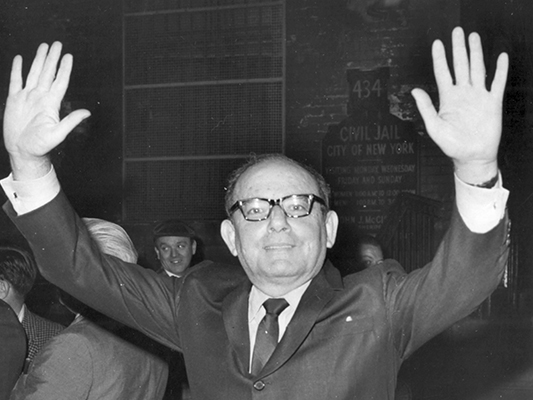Santo Trafficante Jr.

Born: November 15, 1914, Tampa, Florida
Died: March 17, 1987, Houston, Texas
Nicknames: The Silent Don
Associates: Sam Giancana, Charlie “Lucky” Luciano, Meyer Lansky, Cuba, Fidel Castro, Johnny Rosselli, Robert Maheu
Santo Trafficante Sr. was a Florida mobster who survived a series of vicious gang wars to become the leader of a powerful Mafia crime family based in Tampa. His son, Santo Trafficante Jr., took over the crime family and became tangled in a web of conspiracies to kill the leader of revolutionary Cuba and, it is rumored, President John F. Kennedy.
Trafficante’s father was the lucky survivor of what was called the “Era of Blood,” when rival gangs based in Tampa fought for control of Prohibition-era nightclubs and, crucially, the local numbers rackets called “bolitas.” Battling Mob rivals in South Florida essentially weakened each other financially and, through murder, the number of available soldiers. Trafficante Sr. hung back and developed relationships with politicians and his Mob colleagues in New York and Chicago. By the time Prohibition and the Era of Blood ended, he was the top man in the Florida Mafia, operating with the blessing of exiled Mob boss Charlie “Lucky” Luciano, Frank Costello of the Five Families, and Meyer Lansky of the national Syndicate.
In 1946, Santo Sr. sent his son, already a family underboss, to Cuba to invest in the growing number of nightclubs and casinos in the island nation. The Trafficante family formed a strong alliance with the Batista government in Cuba and profited from their investments, although they never achieved the goal of dominating gambling on the island.
In 1954, Santo Sr. died of natural causes (at a time when some of his remaining rivals were still being violently dispatched), and his son took over leadership of the crime family. According to Scott M. Deitche in The Silent Don, the family was profiting not only from its offshore casinos but from narcotics trafficking. It was clear that federal and local law enforcement had an acute interest in the Trafficante family. Santo Jr. was indicted several times through the 1950s but was convicted only once, on state charges in 1954 for bribery, and that conviction was overturned by the Florida Supreme Court. Trafficante was arrested again in 1957 for attending the famous Apalachin summit of Mob leaders in New York, but those charges were dropped.
In 1959, the Cuban Revolution toppled the corrupt Batista government and the rebel leader, Fidel Castro, nationalized foreign-owned properties and shuttered the casinos, a huge financial blow to Trafficante, who was second only to Meyer Lansky in the depth of his investments in Havana. The seeds for Trafficante’s most interesting historical chapter were planted, as the mobster would go on to have a well-established relationship with the CIA in an ongoing effort to assassinate Castro.
Ex-FBI agent and later Howard Hughes aide Robert Maheu of Las Vegas was one of the primary go-betweens for Trafficante. Mobster Johnny Rosselli, who worked for both Trafficante and the Chicago Outfit, was another associate involved in the unsuccessful efforts to kill Castro – and, according to some biographies, was the man who put Trafficante and Giancana together with Maheu.
Rosselli later claimed to be involved with – or to actually be a shooter in – a Mob conspiracy to kill President John F. Kennedy, and some accounts have Trafficante involved in the alleged, and unproven, conspiracy. Rosselli testified in 1975 to the Senate Select Committee on Intelligence on the efforts to kill Castro. He was again called to testify in April 1976 on the alleged conspiracy to kill Kennedy, but Rosselli never made it: His body was found in a barrel floating in Biscayne Bay off the coast of Florida.
Trafficante weathered the violence of Florida’s Mob wars and the various conspiracy theories, the Cuban Revolution and the loss of his offshore casinos, as well as intense law enforcement scrutiny, without ever spending time in prison. One of the last surviving mobsters from the Luciano era, he died of heart disease in a Houston, Texas, hospital in 1987.




